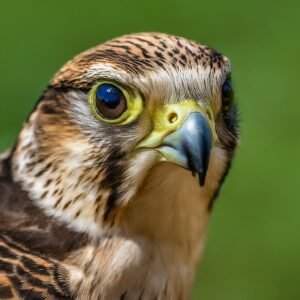The Mighty Falcon: Ruler of the Heavens
About Falcon:
World of Finches
the same sense of amazement and awe in the enormous fabric of the natural world as the falcon For a long time. People have considered the falcon to be the pinnacle of bird power. And grace because of its elegant shape, remarkable speed. And keen senses This amazing bird never ceases to enthrall and inspire. From the traditions of falconry in antiquity to contemporary scientific research.
A Sign of Power and Quickness
About Falcon: The falcon is a member of the Falconidae family, which is recognized for its superb hunting skills. The fastest animal on Earth is the peregrine falcon Falco peregrinus which can reach nearly 240 miles per hour (386 kilometers per hour) during its trademark high-speed dives, or stoops, while hunting prey.
This unmatched speed is a result of the falcon’s amazing adaptations rather than just physical prowess. Its long, pointed wings, streamlined body, and astute aerodynamic design reduce drag and optimize efficiency, enabling it to reach incredible speeds as it crashes with precise accuracy at its target.
Masters of the Hunt: The age-old practice of using trained birds of prey for hunting offers insight into the hunting skills of falcons. For many years, people have coexisted peacefully with these amazing birds, using their natural hunting instincts to take down anything from small animals to other birds.
Defenders of the Heavens
About Falcon: As defenders of the skies, falcons serve an important ecological role in addition to being apex predators. As apex predators, they support the control of lesser animal populations, preserving the fragile equilibrium of ecosystems. Falcons have even adapted to breeding atop skyscrapers and other man-made structures in urban settings, where they act as ambassadors for animal conservation and assist in managing insect populations.
In recent years, efforts to preserve falcon populations have yielded notable achievements. Falcon populations around the world have increased as a result of conservation efforts targeted at lowering pesticide usage, protecting natural habitats, and keeping an eye on nesting locations. Public awareness efforts have also contributed to a greater understanding of the significance of protecting these magnificent birds and the ecosystems they live in.
Sources of Inspiration for Culture and Art
Falcons have elicited wonder and admiration in cultures all around the world throughout history. Ancient Egyptians held falcons in high regard as representations of heavenly defense and identified them with the god Horus. Similar to this, falconry was a well-liked hobby among nobles in medieval Europe, and falcons were highly regarded for their skill at hunting and their majestic demeanor.
The grace and strength of the falcon have also made a lasting impression on literature, art, and popular culture. These birds have captured people’s attention for centuries, from noble falconers in medieval tapestries to brave falcon characters in contemporary movies.
Obstacles and Preservation
About Falcon: In the modern world, falcons face many risks despite their iconic status. Globally, falcon populations face serious threats from illicit poaching, pollution, habitat loss, and climate change. Particularly detrimental effects on falcons and other prey birds have resulted in population decreases and decreased reproductive success due to the use of pesticides like DDT.
Researchers and conservationists are working nonstop to save falcons and their habitats in the face of these challenges. They seek to provide a better future for these amazing birds by researching falcon behavior, keeping an eye on breeding locations, and putting conservation measures into place.
facts about falcons
Speed Demons: Falcons are known for moving at extremely high speeds. When diving to capture prey, the peregrine falcon, in particular, may achieve speeds of nearly 240 miles per hour (386 kilometers per hour), making it the fastest animal on Earth.
Sharp Eyesight: It is estimated that falcons have eight times the sharpness of human eyesight. They soar high in the sky and can see prey from a vast distance thanks to their acute vision.
While the majority of falcons hunt during the day, certain species, like the New Zealand falcon and the northern hawk-owl. Are nocturnal hunters, using the cover of darkness to capture their prey.
Superb Hunters: Falcons are skilled hunters who use a range of tactics based on their environment and prey. Falcons are hunters’ masters, capable of everything from fast dives to surprise strikes from concealed perches
Falconry Tradition: The skill of using trained falcons for hunting has been around for thousands of years. And is highly valued in many cultures. Trained falcons can capture anything from small birds to larger creatures, and they develop close relationships with their human handlers.

In summary
About Falcon: There are not many animals in the sky that inspire as much awe and reverence as the falcon. This amazing bird never ceases to enthrall and amaze people with its unmatched speed, sharp intellect, and magnificent presence.
The falcon’s legacy lives on as a representation of power, independence. And tenacity, from antiquated falconry customs to contemporary conservation initiatives. We are reminded of the significance of maintaining the natural environment. And paying respect to the creatures who call it home as we work to safeguard these wonderful birds. And the ecosystems they live in. The beautiful flight of the falcon serves as a reminder of the wonder and beauty of the natural world.
